
Purdue University is collaborating with three other institutions to build the foundation for space operations to, from and throughout the Earth and moon neighborhood. This area, called the cislunar region, is an enormous, three-dimensional volume of space with many complex factors to be incorporated by mission planners and spacecraft designers.
Teams from the University of Texas at Austin, Penn State and Georgia Tech as well as Purdue will look at challenges to path planning, navigation and control, within the context of space domain awareness in cislunar space. They plan to im- prove the understanding of pathways throughout the region, and leverage these insights to track and predict the locations of objects beyond geosynchronous orbit (xGEO). The unique dynamical characteristics of this region of space and the as- sociated pathways will then be incorporated into spacecraft navigation and control responses.
The resulting tools will aid government agencies and commercial operators to successfully operate missions in cislunar space — and even into deep space — more sustainably.
This multidisciplinary and intercollegiate proposal, called the Characterizing Highways and Automated Navigation in Cislunar Environment (CHANCE) project, received $4.5 million in funding from the Air Force Office of Scientific Research (AFOSR) in July 2023.
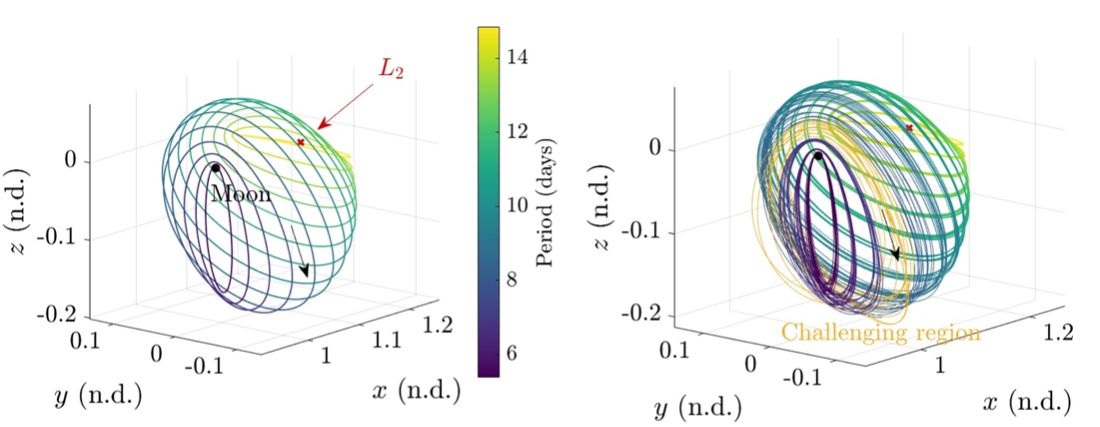
CHANCE will address challenges with Earth-Moon L2 halo orbits and Circular Restricted 3-Body Problems (CR3BP). The diagrams show these orbits in the CR3BP (left), and transitioned to an ephemeris model including a notable region (in yellow) with particularly challenging dynamics for transition.
Though humans first landed on the moon more than half a century ago, getting there (and staying there) still isn’t easy, says Kathleen Howell, the Hsu Lo Distinguished Professor of Aeronautics and Astronautics at Purdue and principal investi- gator on CHANCE.
At its core, CHANCE is about describing and communicating the infinite number of complex orbits possible in cislunar space. This work is foundational even for practical trajectory studies: "It aims to develop the right data structures and computational algorithms for planning and assessing the orbital trajectories, while also supporting the needs of navigation and control system designers.
“For Apollo, the mission was to get to the moon, visit briefly, come back. If we want to stay, we have to know how the environment evolves over time and the other opportunities there are for return as well as move throughout the region,” Howell says. “Getting to [the Lunar] Gateway is particularly difficult because we’ll be going to an orbit that is not as familiar and has not hosted a such a facility previously for long-term operation, which is, in some ways, more challenging than landing on the moon.”
This foundational work will also support commercial space operators interested in a variety of activities, such as resource extraction, space manufacturing and even tourism. It’s a relatively well-known process to operate and launch satel- lites into low Earth orbit (LEO) — where Earth’s gravity is the primary factor — thanks to the tools developed in recent decades.
Distinguished AAE professor Kathleen Howell was selected to deliver the keynote address at Purdue’s spring 2023 commencement ceremony for master’s and doctor of philosophy students. This continues the university’s commencement tradition of the president inviting an esteemed university faculty member to address students during the graduate degrees ceremony.
“An orbital catalog for trajectories generally in Earth orbit is also available. In LEO, there are cer- tain characteristics that govern spacecraft motion, and catalogs are built upon these characteristics. In cislunar space and xGEO, the use of the same characteristics may no longer be a complete ap- proach to represent many of the trajectories in the xGEO regime,” Howell says.
Part of the research will be in determining ways to locate an object and to track what’s out there, as well as maintain contact. “If I’m trying to track an object, I need to know how to find it and how to best leverage the sensors. With an in- finite number of trajectories, it is not even trivial to determine the path and predict object’s future trajectory,” she says.
The competing gravitational pulls in cislunar space render a sensitive environment. Accurate mission planning and navigation, and even corrective maneuvers, require a lot of precision.
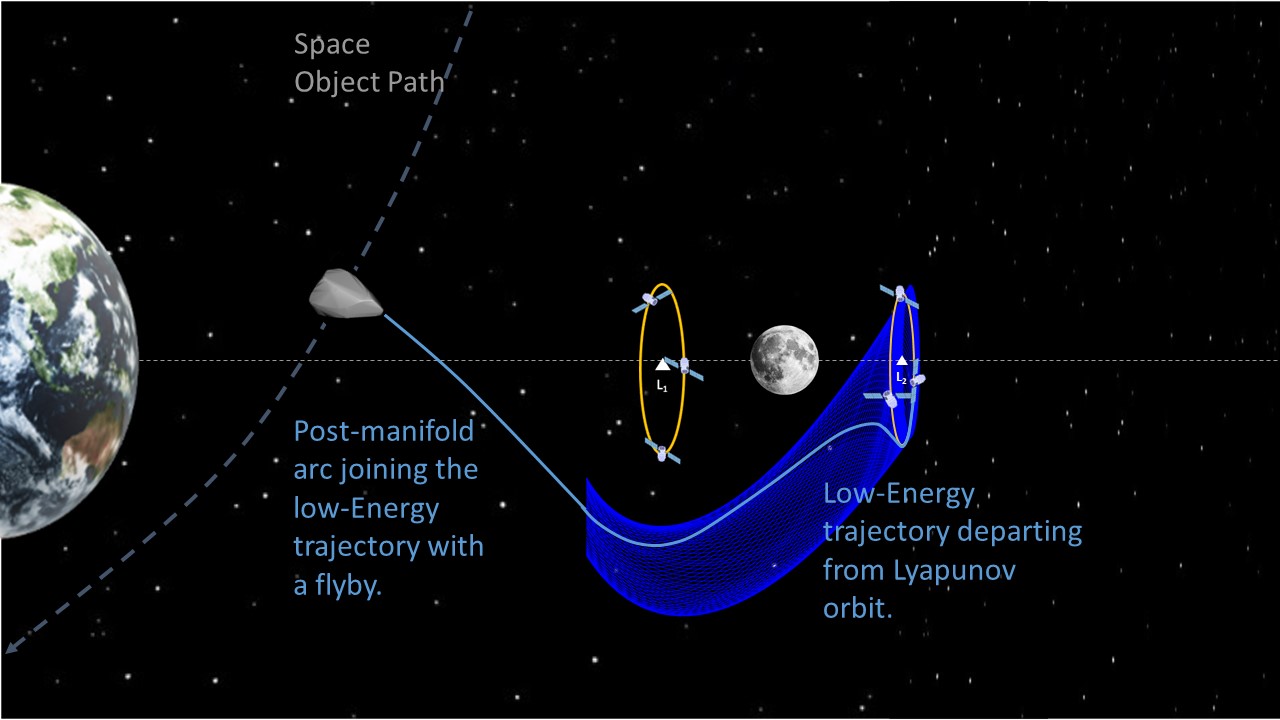
This trajectory design schematic shows rapid response missions to and from quasi-periodic orbits in cislunar space. (Maruthi Akella image)
“Before we can guide the path of an object, we need to know its location. Orbit determination and navigation are all about, essentially, ‘Where is everybody?,’” Howell says. “But when you’re out there, there are potentially many competing forces consistent with the intensity of the gravity fields. The sensors can only deliver a certain degree of accuracy — the sensitivity to error might be of an order similar to the effect of gravity.”
Self-navigating spacecraft may run into an ad- ditional challenge: Limited computing power. As on-board computers are rapidly enhancing their capabilities, autonomy also remains a critical focus of development. Although autonomy is not a focus of this project, it is nevertheless an important development effort for expanded mission options farther from Earth.
“As we plan for potentially more human-crewed missions in cislunar space, it is ever more crucial to gain that critical understanding of the environment as well as a capability for successful navigation and guidance. For successful operations of any vehicle, we don’t want to send it off on a path that’s got only a 50% chance of getting to its destination. Especially if there are humans on board, it has to be accurate 100% of the time to get them home.”
It’s not enough that Howell is a world-renowned expert in multi-body dynamics, or that other leading universities are involved. She shares the Air Force’s perspective that bringing in many voices to a large project like this will produce a better result.
“You can never solve all these problems with only one head. We need more experienced engineers as well as younger researchers. Everyone on the team brings an important perspective that we can’t do without. If you don’t include those voices, you may miss the key element of any particular problem,” Howell says.
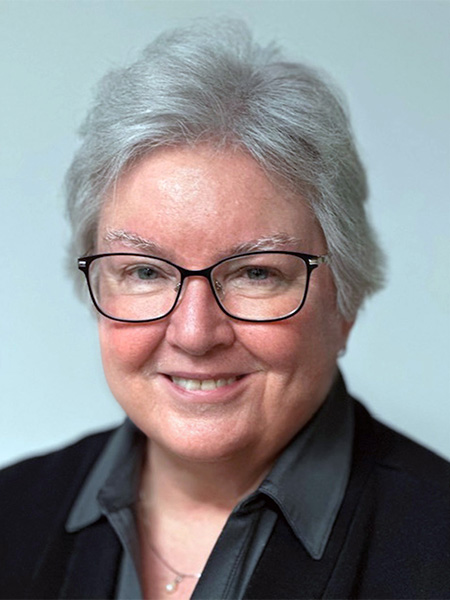
Kathleen Howell, Purdue University
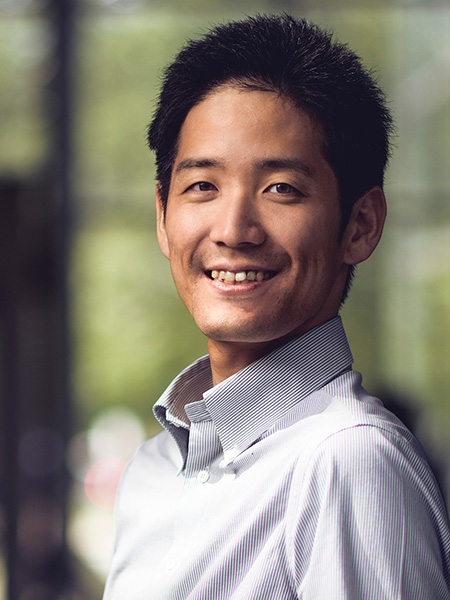

The CHANCE team is substantial, with three full professors, one associate and two assistant professors, and two professors as collaborators. Still, they boast their greatest asset is a squad of 14 graduate students. “They will bring energy,” Howell says. “We want students from different universities to think and interact. Plus, these students aren’t just carrying out a specific set of steps, they’re offering significant assistance.”
It’s big and ambitious, but Howell believes this team can push the work required to make these next giant leaps in human space exploration. It also speaks to her personally.
“I’ve been working in this field for a long time. This project affords an opportunity to expand into space in a sustainable way. If we want to move through the solar system, we’ll need to know how to do all of this.”
“And besides,” she adds, “I like a challenge.”

Fragments of an exploded spacecraft near the moon could travel millions of miles within just a month's time. (Purdue University image/Arly Black and Carolin Frueh)
Carolin Frueh is investigating how to observe and track human-made objects traveling in cislunar space " the area spanning from the Earth all the way to the Moon " and predict where pieces will go if they crash or explode.
We are laying the foundations that we believe will shape how space traffic management problems are addressed in the cislunar region, said Frueh, the Harold DeGroff Associate Professor of Aeronautics and Astronautics.
Approximately 130 million pieces of space debris surround Earth, much of it pieces of satellites that exploded or collided with other objects. Frueh and her students work with international space agencies to improve debris tracking databases, but there arent yet any telescopes in the cislunar region that can support this work.
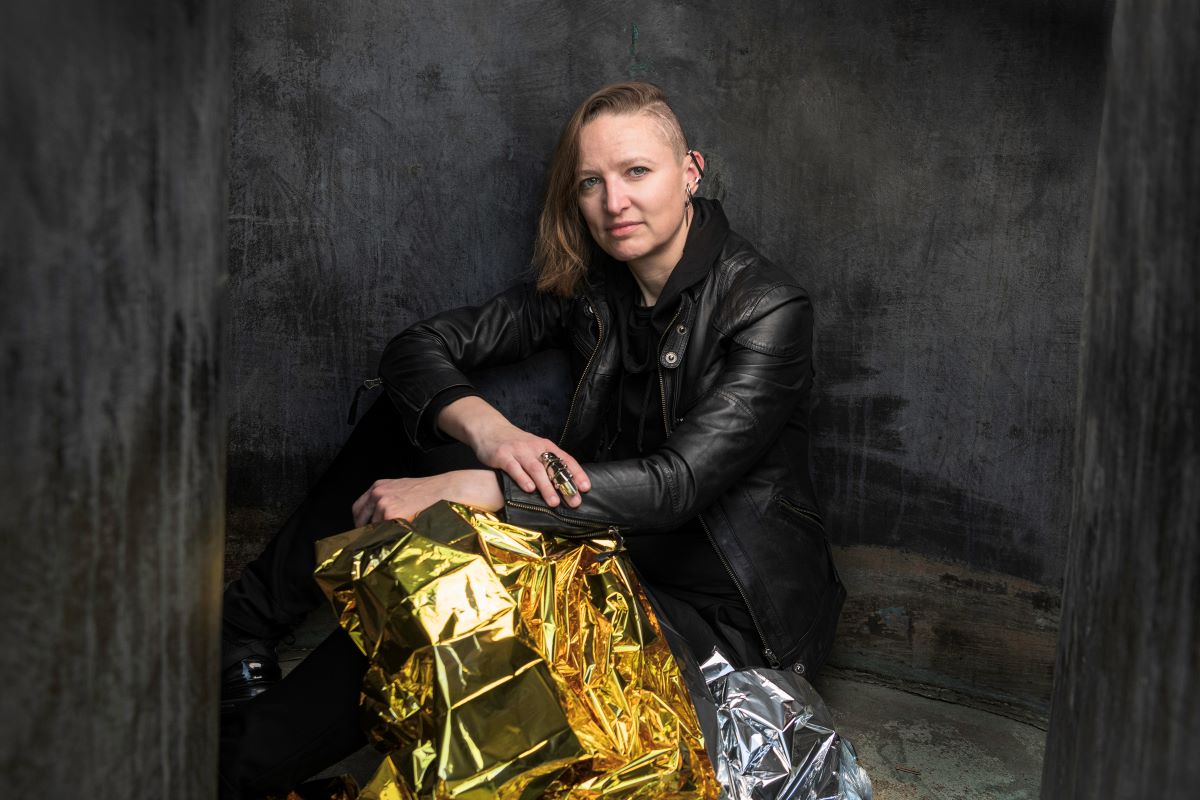
Carolin Frueh is the Harold DeGroff Associate Professor of Aeronautics and Astronautics, effective July 1, 2023. This is one of multiple new term-named professorships established this year through a generous gift from an AAE alumnus.
Frueh and her PhD student, Surabhi Bhadauria, are developing visibility maps that would show the best areas to deploy telescopes to track human-made objects, active or dead. These maps better address constantly changing positions of the Earth, Moon and Sun, which affect what a telescope sees at any given moment. They also run faster and are more comprehensive than existing methods.
But even when telescopes are in place, the satellites they track will likely just look like white dots or streaks. Frueh is accustomed to gleaning meaningful information from these shapes, having done this for near-Earth satellites already. She is not only working on methods to discern the orbits that a satellite is using to do its mission but also information on its orientation and operational state.
And when a collision inevitably happens? Dr. Frueh is thinking ahead working to estimate the damage an accident could cause. Together with her student, Arly Black, they showed that pieces from a fragmented satellite can travel effortlessly all the way back to Earth from deeper into cislunar space.

This illustration shows how one designed origami crease pattern would fit both a 3D elliptical surface (left) and a hyperbolic surface (right). (Purdue University image/Automation and Optimization Laboratory)
The ancient art of folding paper into complex shapes is inspiring new ways to deploy instruments in space.
Associate professor Ran Dai is leading a multi-university effort to automate the unfolding and re-folding of spacecraft components like solar panels and sails, temporary habitats, and even robotic arms.
There are unfolding mechanisms for one-time solar panels deployment after launch, but multiple-time automatic folding and unfolding on board have not been realized, Dai says. For example, we may fold large solar panels under the risk of damage from space debris, and redeploy them after the risk has passed.
Dai is the principal investigator on a collaborative proposal now funded by a $1 million grant from the National Science Foundation. Purdue, Stanford, and the University of Washington will share the grant.